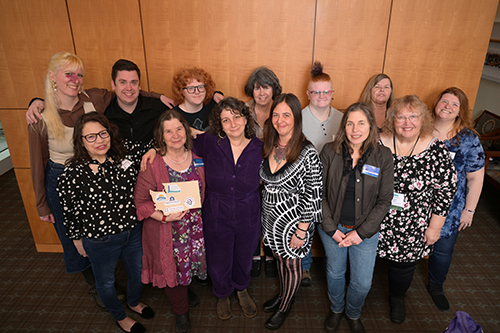
In 2014, there were just five home care cooperatives in the U.S. Since then, the movement has experienced significant growth—growth that was fueled, in part, by support from the Cooperative Development Foundation (CDF).
Margaret Bau, a cooperative development specialist with U.S. Department of Agriculture (USDA) Rural Development, has been there since the beginning. “I am deeply grateful to the Cooperative Development Foundation—both board and staff—for their early support of the development of home care worker cooperatives,” she says. “Thanks to the leadership of the late Liz Bailey for early work in bringing national level attention to the model. Thanks to Leslie Mead for organizing the annual National Home Care Cooperative Conference, which brings together caregivers and developers for mutual learning and support. Thanks to Mary Griffin for supporting the development of the Elevate Cooperative to strengthen local co-op activity.”
In 2016, CDF convened more than 60 members and developers from across the U.S. representing eight of the country’s then nine established home care cooperatives. The National Rural Utilities Cooperative Finance Corporation (CFC) opened their doors to host the event—a tradition they have generously maintained for every National Home Care Cooperative Conference since. CDF’s home care cooperative mission was clear: to support the creation of sustainable home care cooperatives that optimize wages and opportunities for member-owners. The strategy was to enable quality technical assistance, rigorous research, data-driven analysis—and, perhaps most powerfully for the workers involved—the sharing of experiences with other home care developers and cooperatives.
Fast forward to 2024: there are now 21 home care cooperatives with six cooperatives incorporated in 2023 alone.
Fast forward to 2024: there are now 21 home care cooperatives with six cooperatives incorporated in 2023 alone. Thanks in part to CDF’s strategic approach and consistent support, cooperative development centers were able to build capacity to assist at the state and regional level. Across the country, there are numerous startup efforts underway, showcasing the growing interest in this model.
In the years since the Home Care Cooperative Initiative (HCCI) was launched, CDF has brought together the very people caring for some of our communities’ most vulnerable members, empowering care workers to build their cooperative businesses, develop their leadership skills, and share the challenges and successes of their efforts.
“The cooperative form of ownership puts the control of the agency with the caregiver,” said Leslie Mead, who served as executive director during much of CDF’s focus on the HCCI. “That puts the focus on the caregiver and the quality of their jobs. That makes a big difference in retention… and with [better] retention we can assume that we are getting better care to clients. So, everybody wins.”

Nora Edge, a cooperative development specialist with the Northwest Cooperative Development Center, agrees. “We need the co-op difference right now because it does produce a higher quality of care. We are watching caregivers deal with their own aging parents while they are working to care for others as well, so we really need better jobs to support elderly people in our communities. Co-op home care workers feel this tension,” Nora notes. “The industry is changing… baby boomers are aging rapidly and yet senior homes are closing because they cannot recruit staff—there is a crisis that is getting worse by the day, literally,” she concludes. “Caregiver co-ops are trying to make these jobs desirable and make the care affordable. It’s a very hard challenge, but the co-ops are working on it.”
And there is very good reason to do so. “When I started in 2018, the employers were the ticket holders, and the caregivers were the beggars. It was ‘take it or leave it,’” Nora recalls. “Employers were able to get away with a lot, and those jobs were not desirable to caregivers. But because those jobs were treated as entry level [roles], lots of caregivers took them. When COVID hit, it made the jobs that much more difficult and the question of caregiving—and the safety of it—very different,” Nora explains.
“Suddenly the caregivers were the ticket holders and the employers were the beggars. Now, larger home care agencies are working to try to attract caregivers but they’re not successful in keeping them because the quality of the jobs they are offering don’t match. They’re not succeeding in keeping up with quality care and industry change. That’s where home care co-ops have survived this industry change,” Nora concludes, “because home care co-ops are the only industry players that can boast keeping caregivers who now have so much power in this job market.”
“Home care co-ops are the only industry players that can boast keeping caregivers who now have so much power in this job market.” – Nora Edge, cooperative development specialist
The benefits to home care cooperative worker-owners go beyond better jobs and great care. Nearly all workers in the industry are women, and many are women of color, often from modest education and income levels. The opportunity to own and run a business—in a collaborative and supportive way—creates an atmosphere of empowerment that is harder to quantify.

“I feel blessed to have been connected with the cooperative world; it has given me good opportunities of learning, awareness, and knowledge about cooperative business operations and processes,” says Teresita Sattar, a member of Courage Homecare Cooperative. “It gave me a good bridge from being simply a caregiver to becoming a co-owner of a business that I can call my own.”
“That is what it’s about,” notes Paulette LaDouceur, “that is the co-op difference: valuing people and valuing their skills and talent. It’s hard to market that—to capture and convey that it is about mutuality and reciprocity where everyone is benefiting from the relationship they have with each other—and it includes the co-op, the worker, the client, the care.”
“The takeaway is that everybody has something to contribute and everybody learns because we are learning from each other and learning together,” Paulette continues. “Learning in community is very powerful. Because you look at people who have been considered unskilled and show them that they have something to bring to the table and that it has value and that it is important. We aren’t just building a movement, we are building each other up and making our lives better.”


